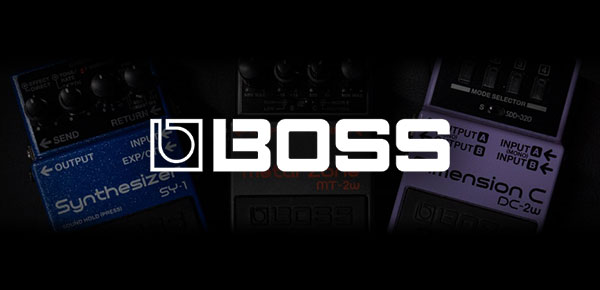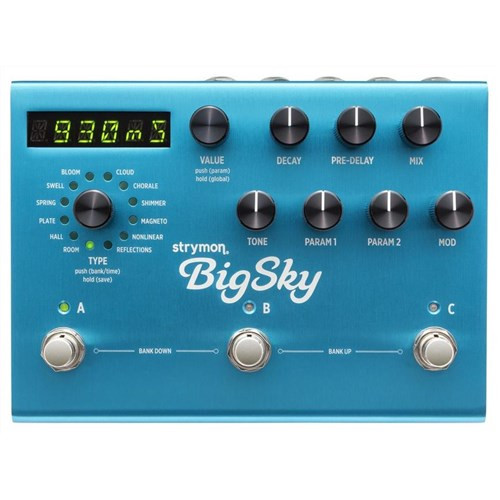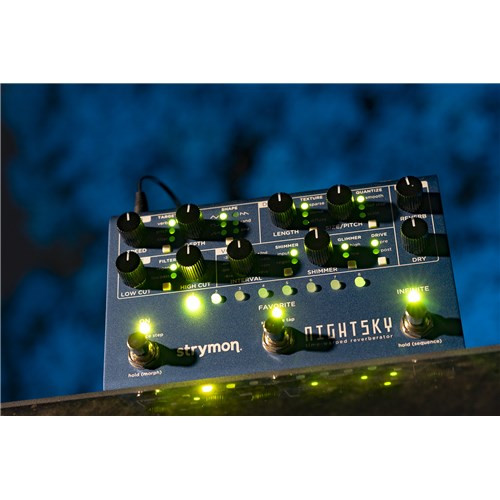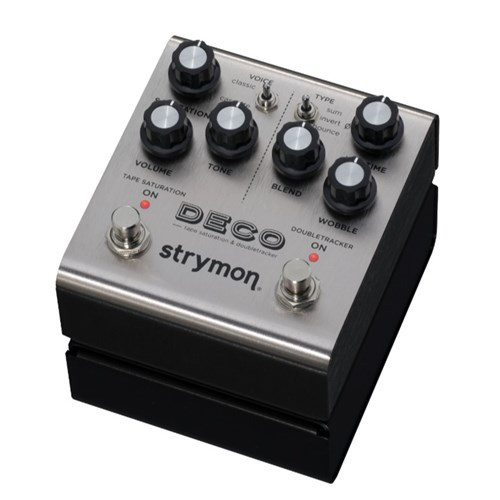Product Description
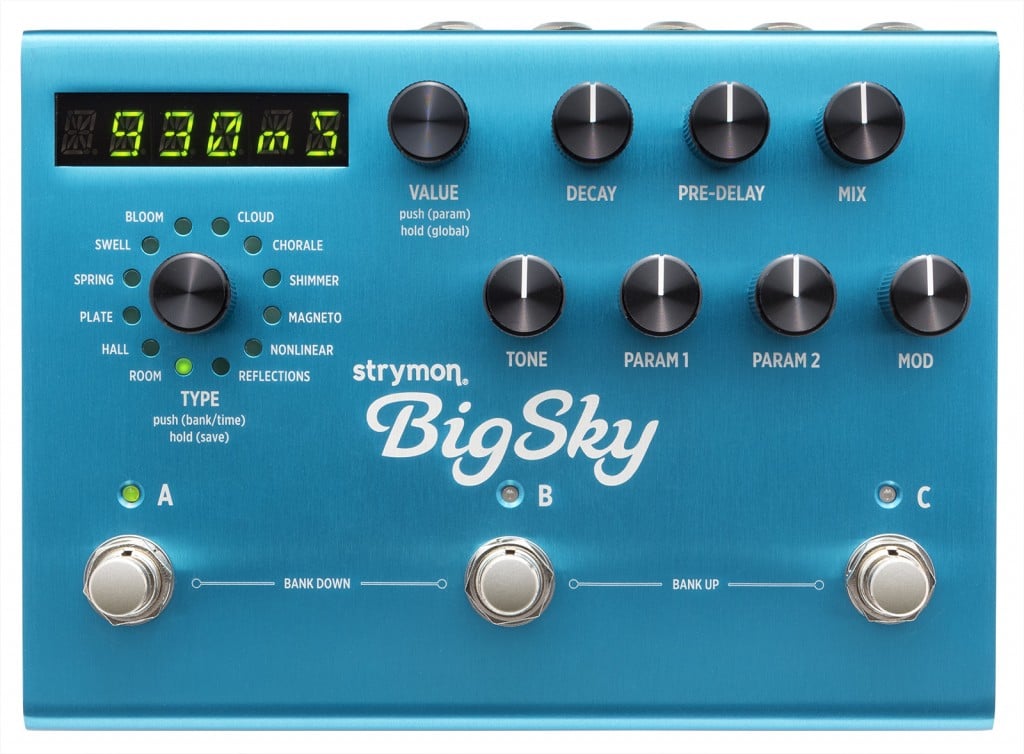
Clear Skies Ahead.
Plug into BigSky and instantly lift your sound into the stratosphere. The world below you fades into the distance, and you’re elevated into a glow of lush, glorious, radiant reverbs.
To create a reverb experience as natural, beautiful, and immersive as BigSky required tremendous feats of sound engineering and artistic imagination. Using the fundamentals of acoustical science as our beacon, we carefully studied and scientifically analyzed reverb technology from the past fifty years. We faithfully captured the essence of these classic sounds, and forged ahead to dream up our vision of reverbs from the future.
Go where no reverb has gone before.
Feel the mechanical tension of the Spring reverbs. Hear the floating particles of the Cloud machine. Defy the laws of physics with the Nonlinear reverbs. Unleash the multi-head reverberations of the Magneto machine. BigSky gives you twelve studio-class reverb machines, each with simple yet powerful controls.
12 Unique Reverb Machines
BigSky gives you twelve studio-class, musically inspirational reverb machines.
Hall Reverb
Diffused reflections and slower-building density are the hallmarks of this beautiful and versatile reverb. The Concert size is well-balanced, spacious and warm, while the Arena size is huge, enveloping and booming.
Plate Reverb
The Plate machine is a rich, fast-building reverb that creates depth without early reflection cues to a specific environment. The Tone knob and Low End parameter are simple but powerful frequency shaping tools.
Spring Reverb
The standalone spring tank became a staple of surf and spaghetti-western music that developed in the ’60s. The Spring machine allows for complete customization from warm and mellow to splashy and dripping with its Tone and Mix Controls, Dwell parameter, and selectable number of springs.
Swell Reverb
The Swell machine brings in the reverb gradually behind the dry signal for subtle evolving textures, like having a volume pedal on the wet signal. Alternatively, you can choose to have the dry signal swelled into the reverb, for maximum ambience and atmosphere.
Bloom Reverb
In the ‘90s, more diffusion blocks were added to reverbs to ‘smooth out’ the sound. A side effect of this was the tendency of the reverbs to have a slowly building envelope that ‘bloomed’, resulting in big ambient reverbs that sit nicely with the dry signal even at high Mix levels. The Bloom reverb features a ‘bloom generating’ section that feeds into a traditional reverb ‘tank’, and adds a unique Feedback parameter that expands the possibilities exponentially.
Cloud Reverb
A gorgeously big, ambient reverb that draws from techniques developed in the late ’70s. Using processing power not dreamed of in those days, the Cloud reverb machine obscures the distinction between reality and fantasy.
Chorale Reverb
A vocal choir accompanies your music. Choose vowel ranges and intensities to customize your choir as it sings in venues that vary with the Decay knob. As the Modulation is increased, the choir becomes alive with multitude of voices.
Shimmer Reverb
Two tunable voices add pitch-shifted tones to the reverberated signal, for resplendent, unearthly ambience. The voices are carefully created from the reverberated signal itself to generate maximum radiance and beauty. The Amount and Mode parameters allow for a range of shimmer effects from laid-back and subtle to full-blown majestic splendor.
Magneto Reverb
A new style of music emerged in the late ’50s, featuring the guitar as the ‘lead voice’ enhanced by the reverberated wash of a multi-head echo. The Magneto machine sets up a multi-head echo with all heads on, while the PreDelay knob adds feedback. The Diffusion parameter adds a new dimension of ambience, smearing the response of the heads and blurring the line between delay and reverb.
Nonlinear Reverb
A variety of physics-defying reverb shapes are available for special effects and unique textures. Choose from three ‘backwards’ shapes (Swoosh, Reverse, and Ramp), or a Gate and more. Feedback control, Late Reverb, and Diffusion parameters allow for a vast array of time-warped possibilities.
Reflections Reverb
The Reflections machine is a psycho-acoustically accurate small-space reverb that allows you to move your amp anywhere in the room. The Reflections algorithm precisely calculates 250 reflections based on the source position within the chosen room shape. The psycho-acoustic modifiers adjust for human auditory perception to create unparalleled ambient-space realism to dry instrument or vocal tracks.
Room Reverb
A versatile room algorithm that creates environments ranging from well-tuned studio ambience to larger night club acoustics. The Tone knob, Diffusion and Low End parameters adjust the damping and scattering effects of room materials, furniture, and people.
Control and Routing
Front Panel Controls
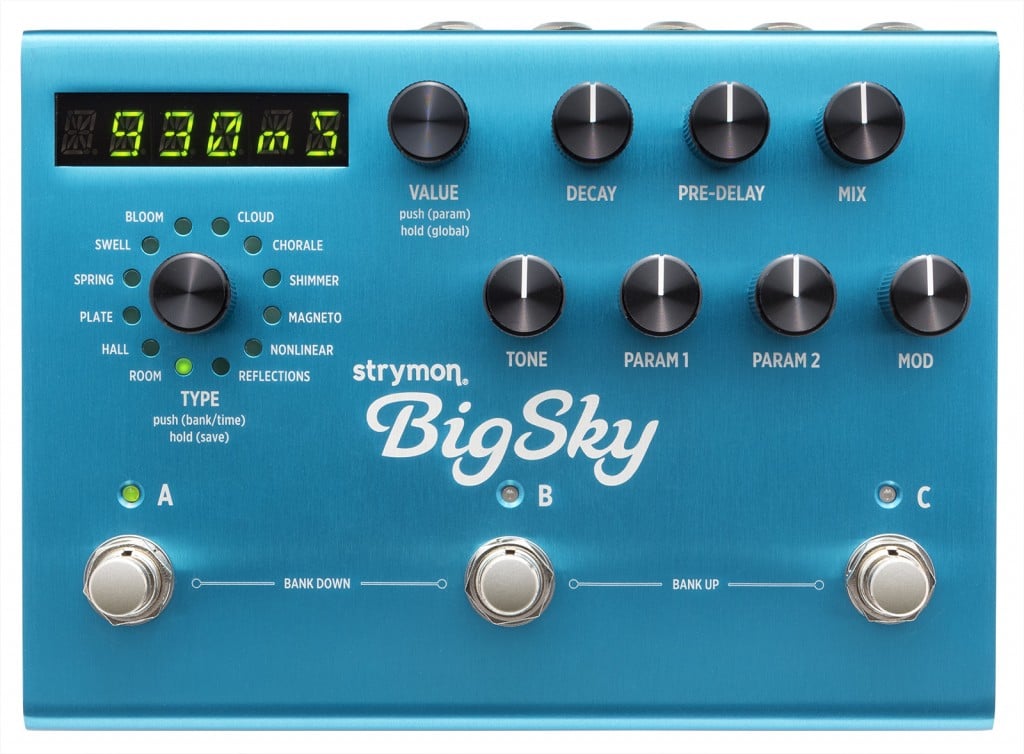
Rear Panel
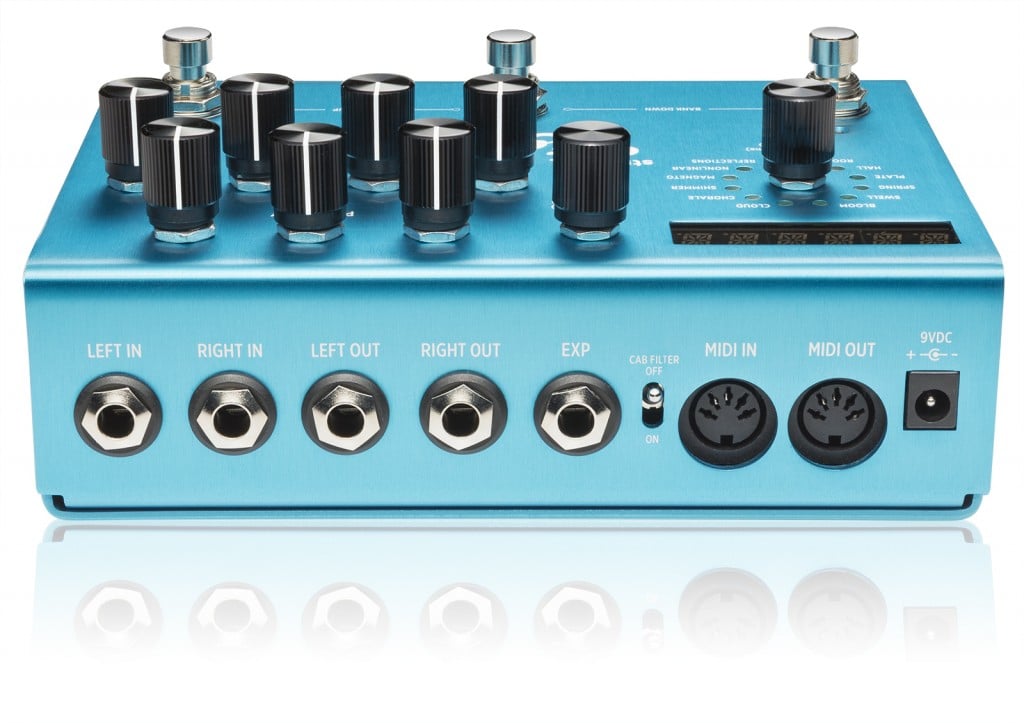
Simple Yet Powerful Controls
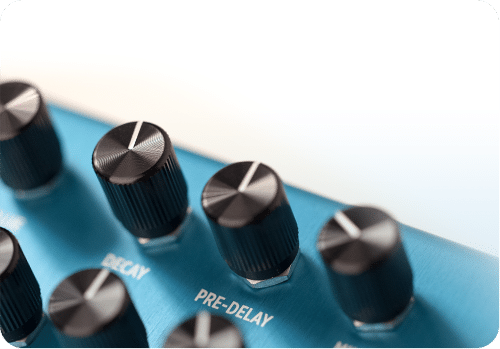
We’ve gone to extraordinarily lengths to craft BigSky to empower your creativity without getting in the way of it.
We’ve hand-picked the most essential reverb controls, and tailored their range and functionality so that sounds can be created effortlessly without extended tweaking.
Specs
Sound Design
- Hand crafted, studio-class reverb algorithms deliver lush, gorgeous, and musically inspiring reverb experiences
- Twelve reverb machines to choose from: Room, Hall, Plate, Spring, Swell, Bloom, Cloud, Chorale, Shimmer, Magneto, Nonlinear, Reflections
- Seven front-panel tone shaping knobs: Decay, Pre-Delay, Mix, Tone, Mod, Param 1, Param 2 (Param knobs assignable per preset)
- Additional menu parameters allow for easy customization of reverb sounds
- 300 easily accessible and namable presets
- Press-and-hold Infinite Sustain and Freeze functions, saveable per preset
- Spillover and Reverb Persist modes, saveable per preset
- Selectable Speaker Cabinet emulation for direct-to-PA gigs or recording applications
Hardware
- Three rugged metal footswitches for preset selection and effect bypass
- LED display for preset info, reverb decay time, and extended parameter control
- Multi-color preset LEDs (green for active preset, amber for edited preset)
- Full MIDI implementation allows extended control for those with more complex rigs
- Sturdy and lightweight light blue anodized aluminum chassis, with laser-etched artwork
- Durable black anodized aluminum knobs
- Studio-grade audio input and output jacks
Ins & Outs
- Stereo input and output
- Expression pedal input with selectable control over any knob or combination of knobs, saveable per preset (also configurable as external tap input)
- MIDI input and output
- Included 9V center-negative power supply (300mA minimum required)
Audio Quality
- Analog dry path for a zero latency dry signal that is never converted to digital
- Premium analog front end and output section
- Ultra low noise, high performance 24-bit 96kHz A/D and D/A converters
- 115dB typical signal to noise at 50% wet mix (120db at 100% dry mix, 109dB at 100% wet mix)
- 20Hz to 20kHz frequency response
- +8dBu maximum input level easily handles instrument and line signals
Processor
- Super high performance DSP in a compact form factor
- 32-bit floating point processing
- 366MHz SIMD SHARC processor core, capable of 2.4 Gigaflops peak performance
More
- True Bypass (electromechanical relay switching)
- High quality, tranparent Analog Buffered Bypass mode
- +/- 3dB Boost/Cut, saveable per preset
- Optional Kill Dry mode mutes dry signal, for use in parallel effects loops
- Dimensions: 6.75″ (171mm) wide, 5.1″ (130mm) deep
- Designed and Built in the USA
Design
Research
“Project BigSky” started as a journey of diligent research.
We studied, reviewed and examined physical reverb units, algorithm architectures, academic papers and programming techniques from the past five decades.
Within BigSky, we utilized traditional reverb elements such as feedback-delay networks, allpass-delay-filter loops, Schroeder reverb sections, multi-tapped delay-lines, as well as all-new reverb elements that we developed along the way.
The goal was to find the best starting point for each reverb sound, and then elevate it into the 21st century.
Sound Design
Our intensive study of reverb history and acoustic science was combined with many critical listening sessions in a variety of environments.
We tweaked in front of amps, with synths, and in recording studios.
We listened with fanatical attention to the early part of the reverb.
We tweaked some more. We listened with fanatical attention to the late part of the reverb. We tweaked some more.
We listened with fanatical attention to the middle part of the reverb.
We tweaked some more.
Then we did it all again. There were no deadlines—just an obsession to make it as good as we could possibly imagine.
Analog Design
Transparency. That is the foundation behind the analog circuitry in BigSky. Only the reverb algorithms color your sound and your analog signal remains untouched.
Our True Bypass circuit accomplishes this with a mechanical relay to switch the input signal directly to the output, with absolutely no components connected.
Our Analog Buffered Bypass circuit features a 1Meg input impedance, keeping the character of your guitar pickup unaltered. The output impedance is 100 Ohms and can drive hundreds of feet of cable without coloring the sound.
Our noise specs are so low they’re about the same as the thermal noise of a guitar pickup.
All Strymon pedals are Designed and Built in the USA.
Does the BigSky have all the features of the blueSky and the Flint’s reverb section?
The BigSky reverb pedal has the three reverb types that are available on the blueSky pedal, however, though they both sound great, they have slight sonic differences. One difference is that you can use the Shimmer effect on each of the different reverb types available on that pedal (Plate, Room, and Spring). Also on the blueSky, the Plate reverb with Shimmer has an octave up, and the Spring and Room types have an octave plus a fifth up. On the BigSky, try setting the MODE parameter in the PARAMS menu to REGEN and using either just +Octave or +Octave & 5th settings.
The era based reverbs on the Flint, however, are unique to that pedal and are not found on the BigSky. These reverbs can be set to sound darker than those found on the BigSky and blueSky pedal.
Mono and Stereo Connections
Each of our Strymon digital effect pedals (excludes OB.1) have the ability to be used with mono or stereo connections. Here are 3 different connection setups you can use with these pedals.
Mono Input => Mono Output
For Compadre, Riverside, and Sunset: Connect a standard mono TS instrument cable into the INPUT and connect a mono TS instrument cable to the OUTPUT of the pedal.
For blueSky and Ola: Connect a mono TS instrument cable into the LEFT INPUT and LEFT OUTPUT for a mono connection.
For BigSky, Mobius, NightSky, TimeLine, and Volante: Connect a mono TS instrument cable into the LEFT INPUT and LEFT OUTPUT for a mono connection. On the TimeLine and Mobius ONLY, make sure that the switch on the back of the pedal is set to STEREO IN/OUT.
For all other Strymon two footswitch Strymon pedals, connect a standard mono TS instrument cable into the INPUT and connect a mono TS instrument cable to the LEFT OUTPUT of the pedal.
Mono Input => Stereo Output
For Mono INPUT and Stereo OUTPUT on our small 2 footswitch pedals: Connect a standard mono TS instrument cable into the INPUT and connect a mono TS instrument cable to both the LEFT and RIGHT OUTPUTS of the pedal. (excludes Compadre, Riverside, and Sunset)
For blueSky and Ola: Connect a mono TS instrument cable into the LEFT INPUT and a mono TS instrument cable to both the LEFT and RIGHT OUTPUTS for stereo output.
For BigSky, Mobius, NightSky, TimeLine, and Volante: Connect a mono TS instrument cable into the LEFT INPUT and both LEFT and RIGHT OUTPUTS for stereo output. On the TimeLine and Mobius ONLY, make sure that the switch on the back of the pedal is set to STEREO IN/OUT.
Stereo Input => Stereo Output
For Stereo input and Stereo output on our small 2 footswitch pedals (except blueSky and Ola), you must first open up the pedal to move the internal jumper over the LEFT 2 pins to set the pedal for TRS Stereo input.
Once the pedal is set for TRS Stereo input, make sure to use a TRS Stereo cable into the INPUT and connect a mono TS instrument cable to both the LEFT and RIGHT OUTPUTS of the pedal.
For blueSky and Ola: Connect a mono TS instrument cable into the LEFT and RIGHT INPUTS along with both LEFT and RIGHT OUTPUTS for stereo input and output. The internal jumper on these pedals does not need to be adjusted to work in stereo and should be left in its default position (connecting the left 2 pins when viewed from below).
For BigSky, Mobius, NightSky, TimeLine, and Volante: Connect a mono TS instrument cable into the LEFT and RIGHT INPUTS along with both LEFT and RIGHT OUTPUTS for stereo input and output. On the TimeLine and Mobius ONLY, make sure that the switch on the back of the pedal is set to STEREO IN/OUT.
What expression pedal can I use?
We have tested the Moog EP-2/EP-3, Roland EV-5, Mission Engineering EP-1 and EP-25K, and they will all work with our pedals to varying degrees. (There may be others but we haven’t tested them yet.)
We recommend using expression pedals that have a minimum 25k ohm or higher potentiometer such as as the Moog EP-3 or Mission Engineering EP-25k.
How to Perform a Factory Reset Procedures on BigSky, TimeLine and Mobius
There are two reset procedures available for BigSky, Mobius, and TimeLine. There is a FACTORY PRESET RESET and a GLOBAL SETTINGS reset.
FACTORY PRESET RESET
Performing a factory preset reset will erase all custom presets you have saved in your BigSky, TimeLine or Mobius. We only suggest you do this in the event you’d like to take your entire pedal’s presets back to the factory settings.
- Power the BigSky, Mobius, or TimeLine on while pressing and holding the A and TAP footswitches (A and C for BigSky) at the same time.
- The display will show REINIT, then, COMPLT when finished. It will remain in this state as long as it is powered.
- Remove power from the pedal, then, re-connect the power to start using it again.
GLOBAL SETTINGS RESET
Performing a Global Settings reset will change all the parameters in the GLOBLS menu back to factory settings.
- Power the BigSky, Mobius, or TimeLine on while pressing and holding down the TYPE encoder button.
- The display will show REINIT, then, R CPLT when finished. It will remain in this state as long as it is powered.
- Remove power from the pedal, then, re-connect the power to start using it again.
How to Change Parameters on BigSky, TimeLine and Mobius
All reverb, delay and modulation machines on BigSky, TimeLine and Mobius share a set of common parameters in addition to some unique ones. Accessing the Parameters menu is easy.
- Press down on Value.
- Use the Value encoder to scroll through the different parameter menu options.
- Press down on Value to access a certain menu option and press down once more to exit out of that menu option after you have made your changes.
- Press down the Type encoder to exit the Parameters menu.
How to Change Global Parameters on BigSky, TimeLine and Mobius
Global settings changes affect the entire BigSky, TimeLine, and Mobius regardless of what preset is active.
- Press and hold Value for about two seconds to access the Global Parameters menu.
- Turn Value to scroll through the different Global menu options.
- Press down on Value to access a specific menu option and turn Value to change the setting.
- Press down on Value to exit the specific setting menu.
- Press Type to exit out of the Global Parameters menu completely.
How do I name and save presets on BigSky?
Instructions
- Access the Globals Menu on the BigSky by holding down the Value encoder for about two seconds.
- Once in the Globals Menu, use the Value encoder to scroll through the menu options and stop when you see “NAMES”
- Press the Value encoder to set the “NAMES” menu option to ON or SCROLL and then press the Type encoder to exit the Globals Menu.
Naming Presets:
- Dial in your custom patch the way you want it.
- Press but DO NOT HOLD the Value encoder to access the Common Parameters Menu.
- Use theValue encoder to scroll through the Common Parameter Menu options and stop on “NAME”.
- Press the Value encoder once to rename your patch. Use the Value encoder to scroll through characters and the Type encoder to move to the next character in the name.
- Once you are finished renaming your patch, press the Value encoder once to exit the “NAME” menu option.
Note: Your custom name will not be saved unless you save your preset after naming.
Saving Presets:
- Hold the Type encoder down for about two seconds.
- Use the Value knob to scroll through the bank location where you want to save your preset.
- Press down either the A or B footswitch to save to the specific channel you want in that bank. The LED screen should momentarily display “SAVING”. Your patch is now saved.
How can I control my Strymon Pedal with MIDI?
If you have a Strymon BigSky, Compadre, Iridium, Mobius, NightSky, Riverside, Sunset, TimeLine, or Volante pedal, you can use MIDI to control or access various parameters and features of the pedal with an external MIDI controller or another device that can send MIDI messages. Please keep in mind that although the MIDI protocol is universal, not all MIDI controllers operate in the same manner or have the same features. Please refer to your MIDI controller’s operation manual for information on how to program the device to only send the MIDI messages you want to your pedals.
How do I assign the PARAM 1 and PARAM 2 knobs on BigSky and Mobius?
To assign the parameter knobs, navigate to any common parameter in BigSky or Mobius, press and hold the VALUE encoder and turn the appropriate parameter button you are assigning to.
Once you have your PARAM 1 or PARAM 2 knobs assigned make sure to save your preset or your settings will be lost.
What happens when I turn the TYPE encoder to change the effect machine?
Each effect machine within your BigSky, TimeLine, or Mobius have both COMMON and UNIQUE parameters. COMMON parameters are available on all effect types. UNIQUE parameters are specific to an effect type.
Here’s what happens when the TYPE encoder is turned:
- New effect machine is loaded
- COMMON parameters are loaded with settings from the current preset
- UNIQUE parameters are loaded from background memory, using values from the last time that effect type was used
What are the power requirements for BigSky?
BigSky requires a power supply that provides 9VDC (center negative) at a minimum of 300mA.
Does my pedal have Balanced or Unbalanced connections?
All of the inputs and outputs on our pedals use MONO TS unbalanced connections. You can use a TRS cable to plug into the inputs and outputs of the pedals, however, there is no benefit to using TRS balanced cable over a MONO TS instrument cable.
Is BigSky a replacement for blueSky?
No, we will continue to build both BigSky and blueSky side by side.

